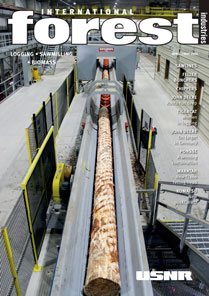EDITOR’S COMMENT ISSUE 75
Searching for silver linings
The last time we published International Forest Industries was our April-May edition, which we put to bed in early April. At that point, lockdown was gripping the UK where our offices are located, mirroring the situation in much of Europe and indeed the Western world.
These column inches were therefore used to speculate on the possible outcomes for the global economy and then the forestry world. We outlined three, broad economic scenarios, from a lifting of restrictions by late summer and a V-shaped recovery; to a prelonged lockdown period and deep recession; to, essentially, Armageddon.
With two months gone, and with the caveat that the world – both forestry and the rest – has probably never seen such uncertainty, we have a better idea of which of those scenarios is likeliest.
For much of the past two months, it has looked like scenario one was most probable and the forestry sector in particular would survive this crisis with but a few scratches. Governments and academics sprung into action and, while there was disagreement over the right course of action, plans were put in place and executed.
Governments had committed more than $15 trillion in relief funding as of early June, some of which has been gifted to medical institutions that are competing with big pharma to find a vaccine.
In forestry, production from sawmills has dropped away as business activity has fallen on the back of trade and travel restrictions. However, while lumber markets remain volatile, the ‘Do It Yourself’ sector gained as locked down citizens across the world take advantage of online or distanced shopping combined with greater free time to catch up on household projects. Building temporary hospitals and major infrastructure projects, meanwhile, added to demand for structural carcassing. The pallets and packaging sectors were also doing well on the back of a strong health and retail sector, according to the European Organisation of the Sawmill Industry.
The markets were also optimistic, though the mood was shifting as we went to press. Major timber stock Catchmark Timber Trust was up almost 30% since at time of writing since my last column; PotlatchDeltic Corp was up more than 30%; while cellulose specialists Rayonier Advanced Materials was up some 140%. Ominously, though, all three were tumbling once more as fears of a second wave of COVID-19 in the US met with awful economic data out of Europe.
And, so, it feels like we’re floating between scenarios one and two.
Lockdown is easing and industry returning, with construction sites that consume huge volumes of timber products opening up once more. But it is not without complication. The UK government, to use my most local example, admits it would ideally like to remain in lockdown until infection levels are far lower, but it is the fear of scenario two that is forcing it to push ahead.
To deal with this risk, governments around the world are relying on a combination of largely untried, or little tried, methods. These include social distancing, shielding of vulnerable people, tracking new infections and isolating, face masks, and then localised lockdowns should the virus again grip pockets of a given country.
These ongoing restrictions are likely to hamper a V-shaped recovery but hopefully stave off a prolonged and deep recession that would spell disaster for the forestry sector and just about every other industry.
The greatest hope of seeing scenario one is the rapid delivery of a vaccine. Over the first few months of work, the news seemed uninspiring, but more recent developments suggest this vaccine could arrive sooner than once imagined.
Should it be proven and administered this year – in what would be a medical first in my understanding – business and markets would respond instantly but, should it arrive late next year or beyond, the forestry sector may have to set itself for a drawn-out period of low economic activity.
Enjoy
Chris Cann





